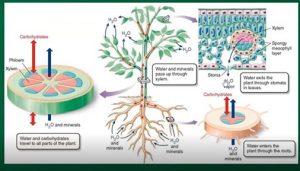Water is the most limiting abiotic (non-living) factor to plant growth and productivity, therefore, plants have developed an effective system to absorb, translocate, store, and utilize water. For example, some large rainforest trees can use nearly 1,200 litters (317 gallons) of water in a single day!
In general, the maximum daily transpiration rates tend to range from 500–2,000 litters (130-520 gallons) for individual trees depending on species and age, (Figure 1).

It’s unbelievable to recognize that plants retain less than 5% of the water they absorb by roots. The remainder passes through plants directly into the atmosphere, in a process called transpiration. So, why if water is so important to plant growth and survival, due they waste so much of it? The answer to this question lies in another process vital to plants — photosynthesis (Figure 2)

To make sugars, plants must absorb carbon dioxide (CO2) from the atmosphere through small pores in their leaves called stomata (Figure 3). When stomata open, water is lost to the atmosphere at a prolific rate relative to the small amount of CO2 absorbed; across plant species an average of 400 water molecules are lost for each CO2 molecule gained. The balance between transpiration and photosynthesis forms an essential compromise in the existence of plants; stomata must remain open to build sugars but risk dehydration in the process.

How do plants carry water from the roots upwards? Plants contain a vast network of conduits, which consists of xylem and phloem tissues. This pathway of water and nutrient transport can be compared with the vascular system that transports blood throughout the human body. But unlike animals, plants lack a metabolically active pump like the heart to move fluid in their vascular system. Instead, water movement is passively driven by pressure and chemical potential gradients (Figure 4).

The bulk of water absorbed and transported through plants is moved by negative pressure generated by the evaporation of water from the leaves (i.e., transpiration) — this process is commonly referred to as the Cohesion-Tension (C-T) mechanism.
This system can function because water is “cohesive” — it sticks to itself through forces generated by hydrogen bonding. (Figure 5). These hydrogen bonds allow water columns in the plant to sustain substantial tension (up to 30 MPa or 4,350 psi when water is contained in the minute capillaries found in plants) and helps explain how water can be transported to tree canopies 100 meters (328 feet) above the soil surface. Scientists call the continuous water transport pathway the Soil Plant Atmosphere Continuum (SPAC).

The next time you see a tree, imagine all of these processes working in sync. Appreciate nature and the incredible trees!
Literature review
Water Uptake and Transport in Vascular Plants
How Much Should You Water Your Tree?
https://www.deeproot.com/blog/blog-entries/how-much-should-you-water-your-tree/
 1
1
